Want some numerical nitty-gritty to go with your debate over House Bill 1182 today? Check out this chart showing the average teacher pay in every South Dakota school district in AY2015, the average pay all of those teachers could get under the funding Governor Daugaard wants to make available in HB 1182, and the average pay those teachers would get if their schools followed the Governor’s recommended staffing levels in Senate Bill 131. (Remember, by my analysis, 120 out of 150 school districts have more teachers than the Governor thinks they should.)
Notice that 39 of the schools listed—most of them small, with the exception of Oglala Lakota, Lead-Deadwood, and Sisseton—come up with less money per teacher at current staffing levels. Everybody is getting more money; how can those 39 schools’ average teacher salary drop?
The answer may lie in the funding formula of SB 131. Based on his Blue Ribbon K-12 panel’s calculations, Governor Daugaard figures that benefits should equal 29% of the average teacher salary and that non-instructional overhead should equal 31% of teacher pay plus benefits. Do the math, and those numbers mean that the Governor anticipates that schools will spend 59.18% of their general fund on teacher pay.
According to the AY2015 data, the 39 schools with negative pay outcomes applying the HB 1182 funding under the SB 131 assumptions for benefits and overhead are all spending more than 59.18% of their state-calculated need on teacher pay. Translation: they’re already scrimping and saving on benefits and overhead to pay their teachers more. They’re already seeking efficiencies well beyond the current state average, which sees 57.96% of the state’s calculated local K-12 need spent on teacher salaries.
To ask those schools to cut back even further by canning teachers is kind of like telling a friend who’s been dieting and exercising to lose weight that what she really needs to do is cut off her leg.
77 schools are already spending a greater share of their state-calcuated aid on teacher pay than the Governor’s plan suggests they should. Maybe instead of fiddling with the formula, we should simplify matters, collect the money from HB 1182 or the superior SB 151, and just send the teachers bonus checks straight from Pierre.
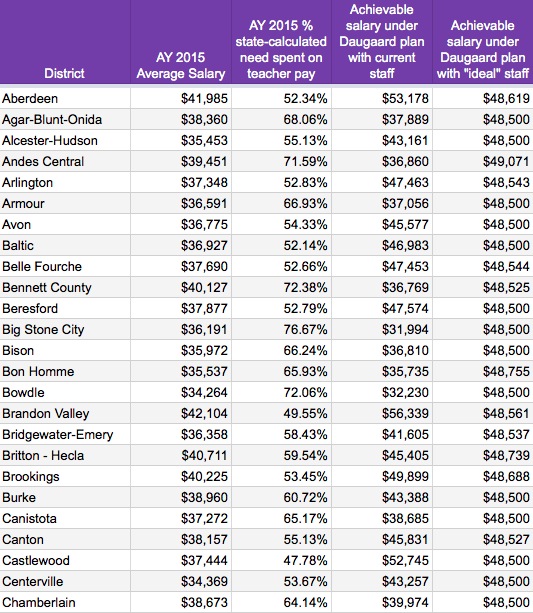
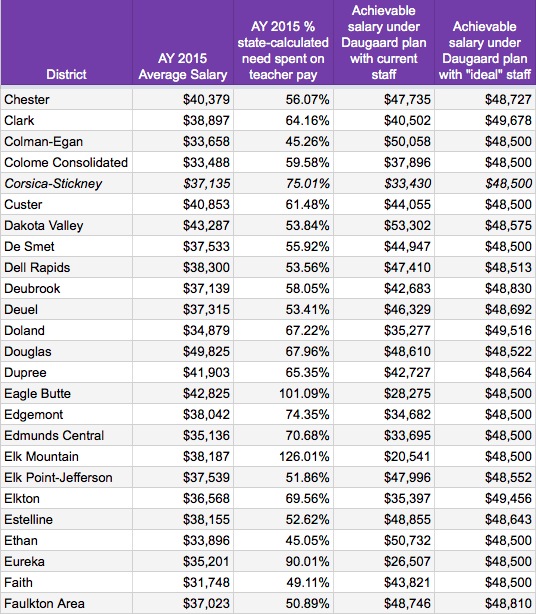
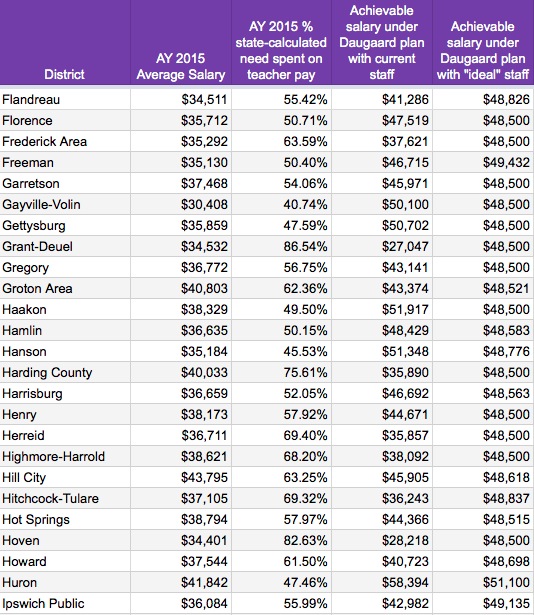
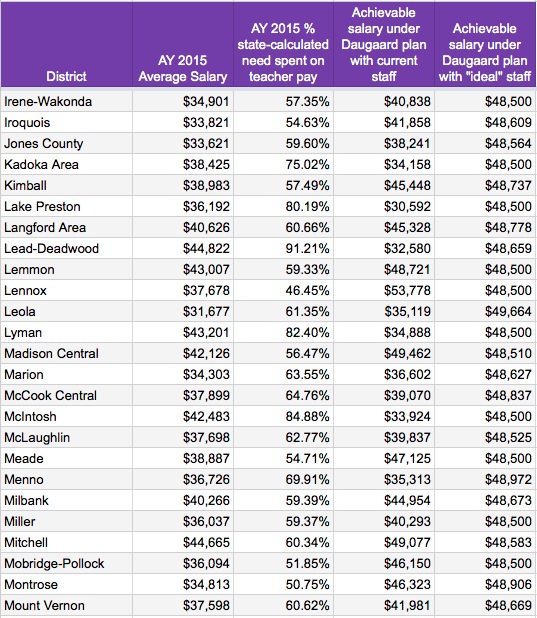

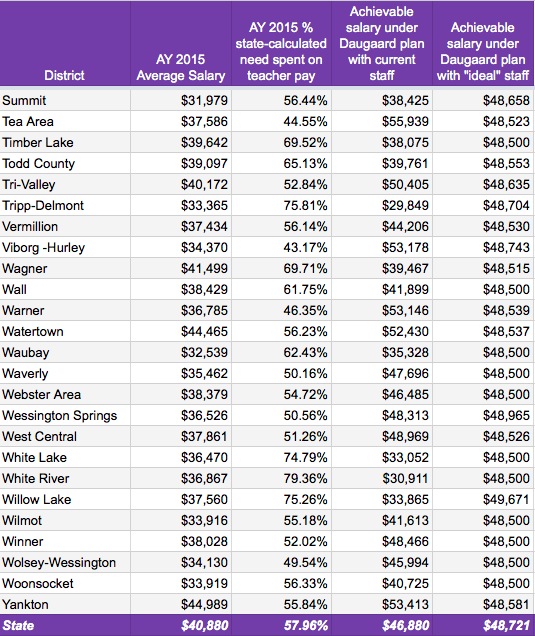
This now seems like a mis-application of a story problem. The whole thesis of the “Achievable salary under Daugaard plan” column is wrong. Doing a district calculation this way would mean that there would be larger amounts of salary money to spend that would allow EITHER even higher salaries or classroom size reductions – districts can make that choice (or do part of each). The claim that schools would be more limited in achievable salaries is really mis-informative. The chart above leaves money on the table that is not accounted for in Cory’s analysis; it assumes far too much of doing things the way they are done now. Schools dedicated to better salaries certainly can and should continue that policy direction.
The only calculation that really matters is the bottom line: how much does a district get now; how much MORE will it get under the new funding? (And how can salaries be moved with that the totality of new, available funding?) How that money is divided (as it is now) resides with local decision making (through collective bargaining).
This analysis is just bad math based on bad assumptions.
No, O, the chart above talks about all of the money that the Blue Ribbon plan puts on the table—aid under new ideal-student-teacher ratio formula plus English language learning factor. It factors back out the overhead and benefits and divides the remaining salary amount by the number of teachers on staff in 2014–2015 and by the target number of teachers proposed in the new formula and produces the two salary estimates as representations of the fiscal world the Blue Ribbon anticipates. It’s pretty straightforward math baed on the assumptions of the Governor’s own plan, Senate Bill 131. I welcome further analysis to clarify exactly which numbers are wrong.
If you want a chart of total new money for each school district, see Column AA of the spreadsheet:
https://docs.google.com/spreadsheets/d/1jK2THutn-GKGqkHmq21N4B1LJ2ud80p0a_myP4LmAvo/edit#gid=0
$81.9 million new statewide. $13.8M new for Sioux Falls, $8.1M for Rapid City, $2.6M for Aberdeen, $2.3M for Watertown…
Cory, I disagree in way that you rigidly keep salary in its lane and only its lane. Several of the applications of the funds are the worst possible application. Some of those lines are straw men.
Additionally, money for salary can also come from the 31% overhead IF funding decisions are made to that purpose (such as sharing administrative or service costs); there is flexibility in continued use of opt-out funds and use of capital outlay funds or even reserve reductions where applicable (and are applicable to some of the locals in your chart). Your analysis keeps all salary devotions in defined lanes, and that is not what this formula does.
One thing that I seriously dislike about so many of the teacher pay conversations going on is that we’re only seeing AVERAGE teacher pay discussed. If a school district has a higher number of more experienced teachers, that misleadingly drives up the number. Yes, higher average pay is important in retaining teachers, but getting the starting salary up to an appropriate level and keeping class sizes down so the teachers aren’t even more overworked are big problems here. If you aren’t for increasing pay I sure hope you can open your eyes wide enough to understand that increasing class size is a direct detriment to the students of South Dakota. If you think it’s okay to give pay increases but tie them to teacher cuts and class size increases then shame on you! And if you think this mystery math formula is a way to combat the teacher shortage in SD you are wrong. New, young teachers aren’t going to be enticed to keep their talents in SD in hopes of meeting a better ‘average salary’ in ten or twenty years. They will keep on doing what they’re doing right now…leaving SD for states where they can do the same job for more money.
“worst possible application”? I thought I was applying the funds exactly as the Governor’s SB 131 specifies. I understand that the formula does not mandate the pay/benefits/overhead ratios. I note clearly above that apparently a lot of schools don’t follow those ratios, and I suspect they’ll continue not to follow those ratios with new money received. But the Governor’s formula must assume that those ratios represent some sensible middle way of doing business. The charts above make clear what teacher pay would look like if all the schools followed Governor Daugaard’s formula exactly.
Here is the flaw in this presentation of numbers:
Using the information from the above chart together with the numbers form column AA in the referenced google document we get these examples:
1) Andes Central (if it decides to keep current staffing levels) goes from a salary of $39,451 to $36,860 – a reduction of $2,591 per teacher — even though they will receive $242,854 in increased funding. One cannot make the argument implicit to the analysis on this post’s chart that Andes Central will do that.
2) Wagner (again, if it decides to keep current staffing levels) goes from a salary of $41,499 to $39,467 – a reduction of $2,032 per teacher — even though they will receive $488,152 in increased funding. Again, I don’t see the argument for Wagner doing that.
I admire your work to help explain the effects of this funding package, but I think some of the gozeintas are based on bad premises. It is the story problem of three men checking into a hotel and the “missing dollar” math teachers know so well.
I still maintain that cutting teachers is a poor strategy for shoring up a teacher shortage.
“Based on his Blue Ribbon K-12 panel’s calculations, Governor Daugaard figures that benefits should equal 29% of the average teacher salary and that non-instructional overhead should equal 31% of teacher pay plus benefits.”
Hunh? Talk about micromanaging by the State on something that they always say should be local control. I have a better idea.
How about since the state has frozen the school districts ability to raise taxes without an opt out, the school districts send their tax dollars to State government and then state government pay the teachers the wage that they should be getting. If they are going to micromanage anyway, let them manage. Then there will be none of this, “well the school district is sitting on too many reserve funds or paying their superintendent and district staff too much.”
The longer this boil festers, (15 years at least) the more it stinks and the more painful it gets to keep reading about., to say nothing of the teachers having to live and work under these conditions.
Rapid City is using 4.2 (not sure the exact number) million of capital outlay flexibility for teacher raises. If Pierre passes the sales tax, they could choose to no longer use capital outlay money for salaries, which basically means that the new money would be much less than 8.1 million. It would be interesting to know how many districts are utilizing CO flexibility for salaries.
But O, my premises are the Governor’s own funding formula and would result from strict adherence thereto. I’m not trying to say that Lake Andes teachers get less money if we pass this plan; I’m saying Lake Andes will have to do something different from what Governor Daugaard prescribes as ideal to ensure every teacher benefits as much as possible.